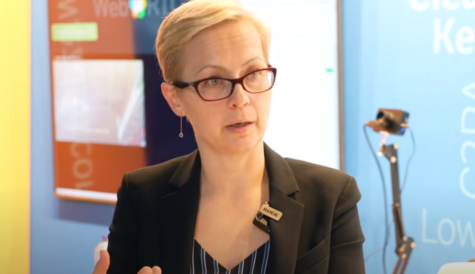
After more than 40 years of operation, DTVE is closing its doors and our website will no longer be updated daily. Thank you for all of your support.
OTTtv World Summit Q&A: Keith Wymbs, Elemental
 Keith Wymbs, vice-president of marketing at Elemental, talked to Digital TV Europe about some of the challenges facing broadcasters in the OTT space – and some of the solutions available.
Keith Wymbs, vice-president of marketing at Elemental, talked to Digital TV Europe about some of the challenges facing broadcasters in the OTT space – and some of the solutions available.
 What are the main challenges broadcasters are facing when it comes to delivering live video to multiple devices? How do the challenges of delivering live video to connected devices differ from the challenges associated with on-demand content?
What are the main challenges broadcasters are facing when it comes to delivering live video to multiple devices? How do the challenges of delivering live video to connected devices differ from the challenges associated with on-demand content?
The main challenge that broadcasters face when delivering live video to multiple devices revolves entirely around the issue of how they are going to make money. And that boils down to costs and the revenues associated with the investment. From a cost perspective, it’s clear that total cost of ownership matters. It’s not just about a one-time capital investment. Rather, it’s imperative to reduce ongoing costs by having extensible integration, easy distribution to a variety of CDNs, low overall operating costs in terms of cooling, power consumption, and the potential to scale to next-generation technologies and new revenue opportunities without a wholesale swap out of infrastructure. Elemental products achieve these goals while addressing pain points for broadcasters by taking a programmatic systems approach based on a Linux operating system, with RESTful APIs, packaged in an innovative software stack that we built in-house to harness the most powerful off-the-shelf hardware components available to the market. It’s a combination that helps our customers like the BBC, Red Bee, TF1, and Eurosport bet on the future without betting the bank. On the revenue side, it’s about producing and delivering premium content. Making it compelling, packaging it properly at the right time and delivering it when the value is at its maximum. By definition, live is premium in the world of sports and other time-sensitive events, but it also has value immediately after the event in the form of repackaged highlights and clips, etc. Turning such content around very quickly is where Elemental solutions provide unique value by leveraging graphics processing units (GPUs) and with homegrown codecs. And then, of course, there is the ability to monetize through targeted advertising. The ability to bridge the divide of traditional broadcast to the various forms of ad insertion in the multiscreen world is a challenging area right now, but it’s one Elemental has been able to solve because of the breadth of experience we have in the multiscreen market implementing standards for broadcasters, Pay TV operators and content programmers and the deep relationships we have with innovative companies in the ad delivery space developing viable solutions for multiscreen video distribution.
What technology solutions has Elemental Technologies developed to help broadcasters deliver live video to multiple devices?
At the core, we have a software architecture that was built from the ground up for creating assets destined for delivery to smart phones, tablets, smart TVs, and other IP connected devices. This core technology is developed in-house, from the ground up to take advantage of the latest off-the-shelf hardware running Intel CPU and NVIDIA graphics processors. The result is the most powerful and yet highly flexibility multiscreen video processing in the industry. We’ve packaged these into a number of products for live encoding – Elemental Live – file based transcoding – Elemental Server – as well as packaging and customization – Elemental Stream. But we’ve also ensured that Elemental software is portable to future software-as-a-service models that will be enabled by cloud-based video processing.
What are broadcasters’ business objectives when delivering live video via the internet?
Tapping into new revenue streams and to maintain or grow the brand equity of the content. The Olympics are a good example. Yes a lot of money is made and spent. Ultimately, however, the Olympic Games represent a loftier value: fair competition. And broadcast rights holders willingly pay a hefty sum to associate with that powerful message. In the end, they can only take advantage of that investment if the experience that is delivered to the end user is top-notch. Elemental provided precisely that this past summer, as the source of multiscreen Olympic content to more than 70 countries across the globe.
How important is it to deliver video of the highest quality to discerning end-users?
For customers who are very discerning, it’s critical. And there are multiple dimensions to making sure it happens. Let’s start where it all begins: with the core compression algorithms. If the video can’t be compressed efficiently, you have a big problem. You’ll find that many pure CPU-based technologies have challenges in this area, particularly when they try to increase system density. You also may discover that corners have been cut in the encoding process in order to provide more outputs from of a single device. You might even be given a quote for a lower quality level. Ultimately, the reduced quality that results from these approaches will do nothing but hurt your brand. On the delivery side, adaptive streaming technologies, whereby a client player only requests the quality level that can be received at a given point in time, have done wonders for the streaming world. Every major video delivery application uses adaptive bit rate streaming today and it’s a big reason for the birth and early success of the multiscreen industry. Elemental products were designed from the ground up for adaptive bit rate streaming. And last, I’d point to hedging one’s bets in terms of the customer experience. Not every CDN is created equal and not all CDNs have the best interest of the end-user in mind. From our point of view, relinquishing control of all video processing to a single CDN is a recipe for disaster in terms of perception of your brand. If the CDN falters you’re essentially dead in the water, and that’s not an enviable position to be in.
What are the benefits of software-based encoding compared with hardware-based approaches?
Today, the video world is awash in disruption and this is not well suited to hardware-based solutions composed of ASICs and DSPs. Open rather than closed networks are being used to deliver bits. Content delivery networks are usurping managed satellite and managed WAN-based topologies as the network of choice for multiscreen delivery. New devices arrive on the scene every year or so to create yet another screen on which to deliver high quality content. Even the codecs themselves will change over the next few years as the next generation of algorithms promising 50% bit rate reductions without sacrifices to overall quality break onto the scene with the adoption of High Efficiency Video Coding (HEVC/H.265). There are new business models to be built that can’t be baked into an ASIC or a DSP without a willingness to wait 18 months as the silicon goes through all the phases of development to cope with the new standard. And even then things will have changed. It’s a dead end road, unless of course you want to recycle your hardware every time change occurs. Can you really afford to do this every quarter? And we haven’t even discussed cloud trends that have collapsed the infrastructure of other industries. Cloud is happening in the video space, and in this area, on-premise, hardware-based solutions simply can’t keep up.
How can operators ensure their back offices are scalable so they can launch new OTT services quickly and efficiently?
This question is really a corollary to the previous question and, as such, might be rephrased as: “Well, why build my video operations based on professional-grade video processing software?” First and foremost, software is infinitely more flexible. By flexible, we mean the ability of the solution to be in the hands of a supportive vendor who can leverage their internal R&D to evolve on behalf of customers in a matter of weeks and months, not quarters or years and to be able to quickly and easily integrate third-party components (for DRM, audio normalization, audio compression, etc.) as market demands change. Second, software based on general-purpose graphics processers is now powerful enough to compete with hardware solutions. By augmenting our solutions with GPUs, we are able to deliver unparalleled software performance while maintaining absolute flexibility. For the first time, software powered by GPUs allow general-purpose platforms to compete head to head with purpose-built hardware solutions in terms of quality, density, and overall cost of ownership. Portability is also key in markets as dynamic as multiscreen – and software is by definition portable when developed on general purpose processors. By portable we mean easy integration across workflows – CMS, DAM, CDN – infrastructures – ground, cloud, hybrid – and streaming technologies – HLS, HDS, SS, MPEG-DASH. From the vantage point of these three advantages, we see ASIC-based technologies from traditional video processing vendors potentially having a very short life span in the video processing space.



